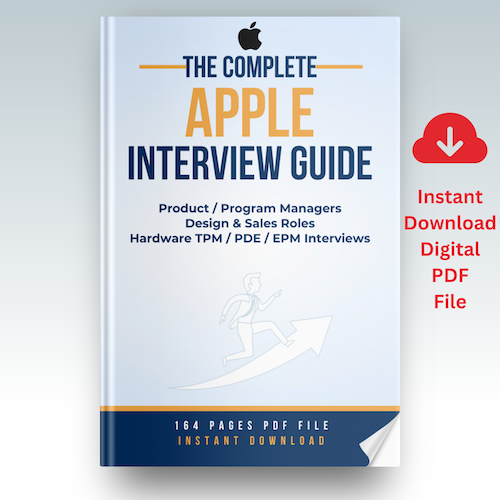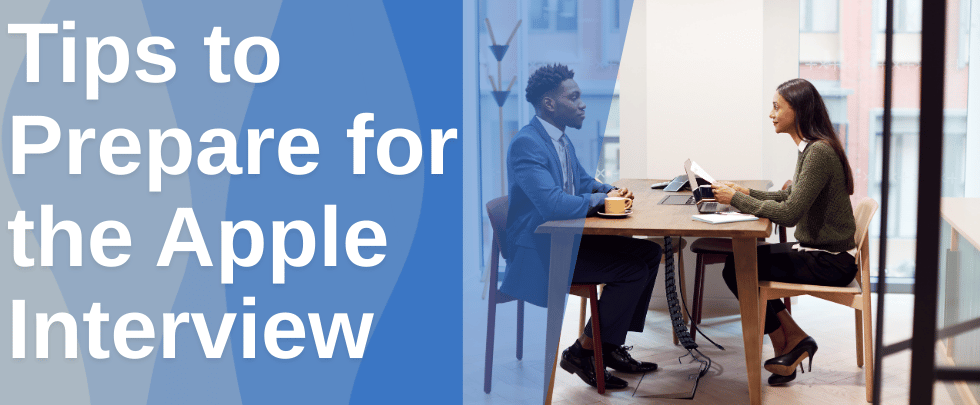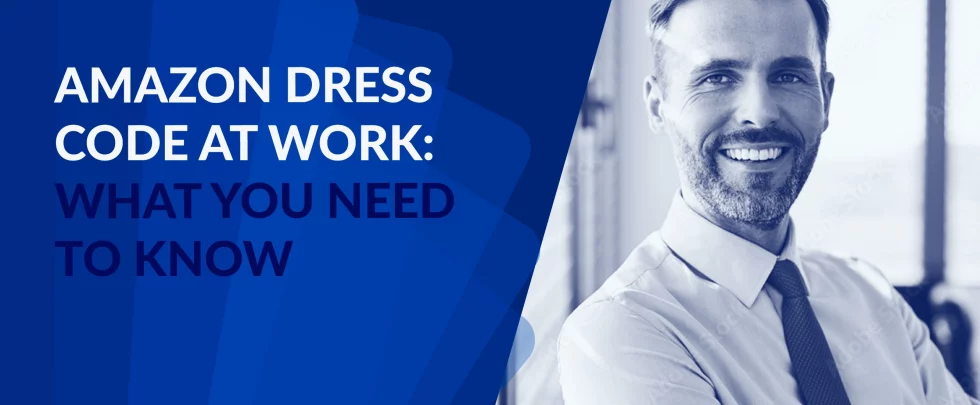In today’s fast-paced and competitive tech world, securing a position at Apple is a dream shared by countless professionals. Known for its groundbreaking innovation, cutting-edge technology, and global impact, Apple offers an unparalleled career opportunity that can transform your professional trajectory.
However, the journey to becoming an Apple employee is as challenging as it is rewarding, demanding thorough preparation, unwavering dedication, and a deep understanding of the company’s ethos. This comprehensive guide will walk you through every essential step to prepare for an Apple interview, significantly boosting your chances of success and helping you stand out in a sea of talented candidates.
Do you have an interview with Apple?
Pro Tip
Make sure to check out our top-selling Apple Interview Guide which comes with a full refund guarantee in case you fail your interviews.

Table of Contents
1. Apple Interview: Decoding Apple’s Culture and Values: The Foundation of Your Preparation
Before diving into the nitty-gritty of interview preparation, it’s crucial to immerse yourself in Apple’s unique culture and values. This foundational knowledge will not only help you align your responses during the interview process but also demonstrate your genuine interest and cultural fit – factors that Apple highly values in potential employees.
Key Apple Values:
- Innovation and Creativity: Apple is synonymous with pushing boundaries and thinking differently. Understand how this applies across all roles in the company.
- User-Centric Design: Every product and service is crafted with the user experience at its core. Familiarize yourself with Apple’s design philosophy.
- Privacy and Security: Apple is a staunch advocate for user privacy. Know their stance and recent initiatives in this area.
- Environmental Responsibility: Sustainability is a key focus. Research Apple’s environmental efforts and goals.
- Diversity and Inclusion: Apple believes diverse teams drive innovation. Understand their commitment to creating an inclusive workplace.
- Excellence and Quality: Apple’s products are known for their premium quality. This ethos extends to their workforce as well.
Action Items:
- Read Apple’s annual environmental progress report.
- Watch past Apple keynotes to understand how they present new innovations.
- Study Apple’s accessibility features to understand their commitment to inclusive design.
- Analyze Apple’s privacy features and compare them with competitors.
Pro Tip: Don’t just memorize facts. Understand the reasoning behind Apple’s decisions and be prepared to discuss how these values align with your own professional ethos.
2. Apple Interview: The Apple Interview Process: A Comprehensive Breakdown
Apple’s interview process is renowned for its thoroughness and complexity. Understanding each stage will help you prepare more effectively and manage your expectations. Here’s a detailed breakdown:
- Initial Application:
- Submit your resume and cover letter through Apple’s careers website.
- Ensure your application highlights relevant skills and experiences that align with Apple’s needs.
- Initial Phone Screening (15-30 minutes):
- A brief call with a recruiter to discuss your background and interest in the position.
- Be prepared to explain your motivation for applying and your understanding of the role.
- Technical Phone Interviews (1-2 rounds, 30-60 minutes each):
- In-depth discussions about your skills and experience with hiring managers or team leads.
- Expect both technical questions and behavioral scenarios.
- Technical FaceTime Interviews (3-5 rounds):
- These interviews dive deep into your technical expertise.
- You may be asked to solve coding problems in real-time using shared editor tools like Codility.
- Be prepared for questions on data structures, algorithms, and system design (for more senior roles).
- On-site Interviews (Full day):
- A series of face-to-face interviews with team members, potential colleagues, and hiring managers.
- Typically includes 5-8 interviews, each lasting 45-60 minutes.
- Expect a mix of technical, behavioral, and cultural fit questions.
- You may have a lunch interview, which, while more casual, is still part of the evaluation process.
- Position Assessment (For some roles):
- May include written exercises, group activities, or role-playing scenarios.
- Designed to evaluate your problem-solving skills, creativity, and role-specific competencies.
- Apple employees will observe and evaluate your performance during group exercises.
- Final Evaluation and Offer:
- The hiring team will convene to discuss your performance across all interviews.
- If successful, you’ll receive a job offer, often followed by salary negotiations.
Pro Tip: Each stage is an opportunity to showcase your skills and passion. Prepare thoroughly for every interaction, even those that seem informal like the lunch interview. For a thorough information about the details of the interview process, please see our Apple Interview Process article.
3. Apple Interview: Honing Your Technical Skills: Becoming an Apple-Caliber Engineer
Apple is at the forefront of technology, so your technical skills need to be razor-sharp. Focus on the following areas:
Programming Languages:
- Swift and Objective-C: Essential for iOS and macOS development.
- Python: Used in various backend services and machine learning applications.
- Java: Important for Android development and some backend services.
- C and C++: Crucial for system-level programming and performance-critical applications.
- JavaScript and Web Technologies: Important for web-based applications and services.
Data Structures and Algorithms:
- Master fundamental data structures (arrays, linked lists, trees, graphs, hash tables).
- Understand time and space complexity analysis.
- Practice implementing and optimizing sorting and searching algorithms.
- Be prepared to solve complex algorithmic problems efficiently.
System Design:
- Understand how to architect scalable and robust systems.
- Know about distributed systems, load balancing, and caching strategies.
- Be familiar with database design and query optimization.
- Understand cloud computing concepts and microservices architecture.
Apple Platforms:
- Gain in-depth knowledge of iOS, macOS, watchOS, and tvOS.
- Understand Apple’s Human Interface Guidelines for each platform.
- Be familiar with core frameworks like Foundation, UIKit, and SwiftUI.
- Know about Apple’s latest technologies like ARKit, Core ML, and HealthKit.
Development Tools and Practices:
- Master Xcode, Apple’s integrated development environment.
- Understand version control systems, particularly Git.
- Be familiar with Continuous Integration/Continuous Deployment (CI/CD) practices.
- Know about test-driven development and unit testing frameworks for Apple platforms.
Resources:
- Use platforms like LeetCode, HackerRank, or CodeSignal to practice coding challenges regularly.
- Participate in open-source projects to gain real-world coding experience.
- Attend Apple’s Worldwide Developers Conference (WWDC) sessions online to stay updated on the latest technologies.
- Read Apple’s official documentation and sample code repositories on GitHub.
Practice Exercise: Implement a basic iOS app that demonstrates your understanding of core iOS concepts like UIKit, Auto Layout, and data persistence. Be prepared to discuss your design decisions and potential optimizations.
4. Apple Interview: Mastering Behavioral Questions: Showcasing Your Soft Skills
Apple values not just technical skills but also soft skills and cultural fit. Be prepared to answer behavioral questions that assess your:
- Problem-solving abilities
- Teamwork and collaboration skills
- Adaptability and learning agility
- Leadership potential
- Conflict resolution skills
- Innovation and creativity
- Customer focus
Example Questions and How to Approach Them:
- “Tell me about a time when you had to deal with a difficult team member. How did you handle it?”
- Use the STAR method (Situation, Task, Action, Result) to structure your response.
- Focus on how you maintained professionalism and found a constructive solution.
- Highlight any lessons learned from the experience.
- “Describe a situation where you had to learn a new technology quickly. How did you approach it?”
- Emphasize your learning strategy and any resources you utilized.
- Discuss how you applied the new knowledge to solve a problem or improve a process.
- Show enthusiasm for continuous learning and adaptability.
- “Give an example of a time when you had to think creatively to solve a problem.”
- Choose an example that showcases innovative thinking and resourcefulness.
- Explain your thought process and any unconventional approaches you considered.
- Highlight the positive outcome and any broader implications of your solution.
- “How do you handle criticism or feedback on your work?”
- Demonstrate your openness to feedback and ability to use it constructively.
- Provide an example where feedback led to personal or professional growth.
- Show how you actively seek out feedback to improve your performance.
- “Describe a project where you had to work with a diverse team. What challenges did you face, and how did you overcome them?”
- Highlight your appreciation for diverse perspectives and inclusive collaboration.
- Discuss specific strategies you used to foster effective communication and teamwork.
- Emphasize the positive outcomes achieved through diversity.
Pro Tip: Prepare 5-7 detailed stories from your professional experience that you can adapt to various behavioral questions. Practice delivering these stories concisely and confidently.
5. Apple Interview: Showcasing Your Passion for Technology: Standing Out as an Apple Enthusiast
Apple looks for candidates who are genuinely passionate about technology and innovation. This enthusiasm should permeate all your interactions during the interview process. Be prepared to discuss:
Recent Tech Trends and Their Potential Impact:
- Artificial Intelligence and Machine Learning advancements
- Augmented Reality (AR) and Virtual Reality (VR) technologies
- 5G and its implications for mobile computing
- Internet of Things (IoT) and smart home technologies
- Quantum computing and its potential applications
Your Favorite Apple Products and Why You Admire Them:
- Choose products you genuinely use and appreciate.
- Discuss both hardware and software aspects.
- Highlight how these products have improved your life or work.
- Be prepared to suggest potential improvements or new features.
Personal Projects or Contributions to Open-Source Initiatives:
- Discuss any side projects related to Apple technologies.
- Highlight contributions to open-source projects, especially those used by Apple.
- Explain how these projects demonstrate your passion and skills.
Apple’s Recent Innovations and Their Significance:
- Be familiar with Apple’s latest product announcements and technological advancements.
- Understand the broader implications of Apple’s innovations in privacy, health, and environmental sustainability.
- Have informed opinions on Apple’s strategic directions and potential future innovations.
Tip: Follow Apple-focused news sites, developer blogs, and official Apple channels to stay updated. Engage in tech community discussions to broaden your perspectives.
Discussion Exercise: Choose a recent Apple innovation (e.g., Apple Silicon, Privacy Labels, or AirTags) and prepare a brief analysis of its technological significance, market impact, and potential future developments. Be ready to present this analysis if the opportunity arises during your interview.
6. Apple Interview: Demonstrating Your Problem-Solving Skills: Thinking Like an Apple Engineer
Apple values employees who can think creatively and solve complex problems. During your interview, you’ll likely face challenging technical questions or scenarios. Here’s how to approach them:
Step-by-Step Problem-Solving Approach:
- Clarify the Problem:
- Ask questions to ensure you fully understand the requirements.
- Identify any constraints or assumptions.
- Restate the problem to confirm your understanding.
- Break Down the Problem:
- Divide the problem into smaller, manageable sub-problems.
- Identify the core components or functionalities needed.
- Propose Initial Solutions:
- Brainstorm multiple approaches to solve the problem.
- Discuss the pros and cons of each approach.
- Choose the most promising solution to start with.
- Implement the Solution:
- Write clean, well-structured code (if it’s a coding problem).
- Explain your thought process as you implement the solution.
- Use meaningful variable names and add comments for clarity.
- Test and Optimize:
- Walk through your solution with test cases.
- Identify edge cases and how your solution handles them.
- Analyze the time and space complexity of your solution.
- Propose optimizations or alternative approaches if time allows.
- Reflect and Improve:
- Discuss potential scalability issues or real-world considerations.
- Be open to feedback and suggestions from the interviewer.
- Show enthusiasm for iterative improvement and optimization.
Example Technical Problem:
Problem: Design a system for Apple’s new hypothetical smart home device that can efficiently manage and prioritize multiple voice commands from different users in a household.
Approach:
- Clarify: Ask about the number of users, types of commands, response time requirements, and privacy considerations.
- Break Down: Identify key components like voice recognition, user identification, command queuing, and execution systems.
- Propose Solutions: Discuss approaches like priority queues, machine learning for user preference learning, and distributed processing.
- Implement: Sketch out a high-level system design, explaining key algorithms and data structures.
- Test and Optimize: Discuss how the system would handle concurrent commands, resolve conflicts, and ensure fair access for all users.
- Reflect: Consider privacy implications, potential for personalization, and integration with existing Apple ecosystems.
Pro Tip: Practice solving complex problems on a whiteboard or paper, explaining your thought process out loud as you go. This will help you communicate your problem-solving approach more effectively during the interview.
7. Apple Interview: Preparing Thoughtful Questions: Demonstrating Your Engagement and Interest
At the end of your interview, you’ll likely have the opportunity to ask questions. This is your chance to demonstrate genuine interest, gather valuable information, and leave a lasting impression. Here are some thoughtful questions to consider, along with the reasoning behind asking them:
- “How does this team contribute to Apple’s overall mission of creating technology that empowers people?”
- Shows your understanding of Apple’s broader goals and your interest in making a meaningful impact.
- Demonstrates that you’re thinking beyond just the job description.
- “Can you describe a recent challenge the team faced and how it was overcome?”
- Provides insight into real-world problems and team dynamics.
- Shows your interest in problem-solving and collaborative work environments.
- “How does Apple foster innovation within this particular team or department?”
- Demonstrates your interest in Apple’s innovative culture.
- Helps you understand how creativity is encouraged in day-to-day work.
- “What opportunities for professional growth and learning exist in this role?”
- Shows your commitment to continuous improvement and long-term career development.
- Helps you understand how Apple invests in its employees.
- “How does the team balance the need for rapid innovation with Apple’s commitment to product excellence and user privacy?”
- Demonstrates your understanding of Apple’s core values and the challenges of the tech industry.
- Shows your ability to think about complex trade-offs in product development.
- “Can you describe the team’s collaborative process when working on new projects, especially given the current hybrid work environment?”
- Shows your interest in teamwork and adaptability to different work settings.
- Helps you understand the day-to-day work environment and communication practices.
- “How does this role or team contribute to Apple’s environmental and accessibility initiatives?”
- Demonstrates your awareness of Apple’s broader corporate responsibilities.
- Shows alignment with Apple’s values beyond just technology.
- “What do you find most rewarding about working at Apple, and specifically on this team?”
- Gives you insight into the company culture from an insider’s perspective.
- Builds rapport with the interviewer by inviting them to share their personal experience.
- “How does Apple approach the balance between maintaining secrecy around new products and fostering a collaborative work environment?”
- Shows your understanding of Apple’s unique position in the industry.
- Demonstrates your ability to handle confidential information responsibly.
- “Can you tell me about a recent product or feature that this team is particularly proud of, and why?”
- Allows you to learn about recent successes and team values.
- Shows your interest in the team’s achievements and the impact of their work.
Remember: Your questions should reflect your research and genuine curiosity about the role and company. Avoid asking about information that’s readily available on Apple’s website or in the job description. Instead, focus on questions that show you’ve thought deeply about the position and its place within Apple’s broader mission.
Pro Tip: Prepare more questions than you think you’ll need. Some of your prepared questions might be answered during the course of the interview, so having extras ensures you’ll always have something thoughtful to ask.
8. Apple Interview: Polishing Your Presentation: Making a Lasting Impression
First impressions matter, especially at a design-conscious company like Apple. Pay meticulous attention to how you present yourself, both in person and virtually:
Dress Code:
- Aim for smart casual unless instructed otherwise.
- For men: Consider a collared shirt with slacks or dark jeans. A blazer can be appropriate for more senior positions.
- For women: A blouse with slacks
- For women: A blouse with slacks or a skirt, or a simple dress can work well. A blazer is also appropriate for more senior roles.
- Avoid overly flashy accessories or strong perfumes/colognes.
- Ensure your clothes are clean, wrinkle-free, and fit well.
Body Language:
- Maintain eye contact to show confidence and engagement.
- Practice a firm handshake (for in-person interviews).
- Sit up straight and lean slightly forward to show interest.
- Use open gestures and avoid crossing your arms, which can appear defensive.
- Smile genuinely to create a positive atmosphere.
Virtual Interview Etiquette:
- Test your technology beforehand (camera, microphone, internet connection).
- Choose a quiet, well-lit location with a neutral background.
- Look directly into the camera to simulate eye contact.
- Dress professionally from head to toe (in case you need to stand up).
- Have a backup plan in case of technical difficulties (phone number, alternate device).
Communication:
- Speak clearly and at a moderate pace.
- Use professional language, avoiding slang or overly casual expressions.
- Listen actively and don’t interrupt the interviewer.
- Take a moment to gather your thoughts before answering complex questions.
- Use specific examples to illustrate your points.
- Show enthusiasm in your voice and facial expressions.
Preparation:
- Research your interviewers on LinkedIn if their names are provided.
- Prepare and practice your “elevator pitch” – a brief, compelling summary of your background and why you’re interested in Apple.
- Have copies of your resume, portfolio, and any other relevant documents readily available.
- Prepare a notebook and pen for taking notes during the interview.
Pro Tip: Practice your interview responses with a friend, mentor, or career coach. Record yourself to analyze your body language and speech patterns. This will help you refine your delivery and boost your confidence.
9. Apple Interview: Understanding Apple’s Product Ecosystem
To truly impress in your Apple interview, you need to demonstrate a deep understanding of Apple’s product ecosystem and how different products and services integrate. This knowledge shows that you grasp the big picture of Apple’s strategy and user experience philosophy.
Key Areas to Focus On:
- Hardware Integration:
- Understand how Apple devices work together (e.g., Continuity features, Handoff, Universal Clipboard).
- Know the latest hardware innovations across product lines (e.g., Apple Silicon, ProMotion displays, LiDAR scanners).
- Software Ecosystem:
- Be familiar with iOS, macOS, watchOS, and tvOS, including recent features and updates.
- Understand the role of services like iCloud, Apple Music, Apple TV+, and Apple Arcade in the ecosystem.
- Privacy and Security Features:
- Know Apple’s stance on user privacy and how it’s implemented across products (e.g., App Tracking Transparency, Privacy Labels).
- Understand security features like Face ID, Touch ID, and end-to-end encryption in iMessage and FaceTime.
- Developer Tools and Frameworks:
- Be aware of key development tools like Xcode, Swift Playgrounds, and TestFlight.
- Understand major frameworks like SwiftUI, ARKit, Core ML, and HealthKit.
- Accessibility Features:
- Know Apple’s commitment to accessibility and key features across products.
- Understand how VoiceOver, Switch Control, and other accessibility technologies work.
- Environmental Initiatives:
- Be familiar with Apple’s environmental goals and initiatives (e.g., carbon neutrality plans, recycling programs).
- Understand how sustainability is incorporated into product design and manufacturing.
Discussion Exercise: Choose two Apple products or services and explain how they integrate to enhance the user experience. Be prepared to discuss potential future integrations or improvements.
10. Apple Interview: Navigating Apple’s Unique Interview Scenarios
Apple is known for sometimes using unconventional interview techniques to assess candidates. Being prepared for these scenarios can help you stand out:
The Lunch Interview:
- While more casual, remember it’s still part of the evaluation.
- Use it as an opportunity to showcase your interpersonal skills and cultural fit.
- Ask thoughtful questions about the team dynamics and company culture.
- Be mindful of your table manners and keep the conversation professional.
The Design Challenge:
- You might be asked to critique an Apple product or suggest improvements.
- Focus on the user experience and align your suggestions with Apple’s design philosophy.
- Consider both aesthetic and functional aspects of design.
- Be prepared to sketch out your ideas, even if you’re not a professional designer.
The “Think Different” Scenario:
- Apple might present you with an unconventional problem to solve.
- Embrace creativity and don’t be afraid to propose out-of-the-box solutions.
- Explain your thought process clearly as you work through the problem.
- Show how you can balance innovation with practicality.
The Team Exercise:
- You might participate in a group activity with other candidates.
- Focus on collaboration rather than competition.
- Demonstrate leadership skills but also know when to step back and support others.
- Show how you can contribute to a positive team dynamic.
Pro Tip: Practice brainstorming solutions to unusual problems. This will help you think on your feet during unexpected interview scenarios.
11. Apple Interview: Post-Interview Follow-Up: Sealing the Deal
Your interaction with Apple doesn’t end when you leave the interview room or log off from your virtual interview. A thoughtful follow-up can reinforce your candidacy and demonstrate your continued interest in the position.
Key Steps for Effective Follow-Up:
- Send Thank-You Notes:
- Email a personalized thank-you note to each interviewer within 24 hours.
- Reference specific points from your conversation to show attentiveness.
- Reiterate your enthusiasm for the position and company.
- Provide Additional Information:
- If you discussed a project or skill that you didn’t fully elaborate on, offer to provide more details.
- Share links to relevant work samples or portfolios if appropriate.
- Address Any Concerns:
- If you feel you didn’t fully answer a question during the interview, you can briefly address it in your follow-up.
- Be concise and frame it positively, focusing on your strengths.
- Stay Patient but Proactive:
- Respect the timeline provided by the recruiter for next steps.
- If you haven’t heard back by the expected date, it’s appropriate to send a polite inquiry.
- Be Prepared for Next Steps:
- Start thinking about potential salary negotiations and your availability for start dates.
- Consider preparing a list of references in case they’re requested.
Example Thank-You Email:
Subject: Thank you for the interview - [Your Name], [Position]
Dear [Interviewer's Name],
Thank you for taking the time to meet with me today to discuss the [Position] role at Apple. I thoroughly enjoyed our conversation about [specific topic discussed] and was particularly excited to learn about [interesting project or aspect of the job].
Your insights into [another topic from the interview] further reinforced my enthusiasm for the opportunity to contribute to Apple's mission of [relevant aspect of Apple's goals]. I'm confident that my experience in [relevant skill] aligns well with the team's needs, and I'm excited about the potential to [specific contribution you could make].
I look forward to hearing about the next steps in the process. Please don't hesitate to contact me if you need any additional information.
Thank you again for your time and consideration.
Best regards,
[Your Name]Pro Tip: Customize each thank-you note to reflect the specific conversations you had with each interviewer. This personal touch can help you stand out in their memory.

Apple Interview Tips Conclusion: Embracing the Apple Challenge
Preparing for an Apple interview is a journey that requires dedication, thorough research, and continuous skill development. By following this comprehensive guide, you’ve equipped yourself with the knowledge and strategies to tackle the interview process with confidence. Remember, each interaction is an opportunity to showcase your unique value and alignment with Apple’s mission.
As you move forward:
- Stay curious and continue learning about Apple’s latest innovations.
- Practice your technical skills regularly and stay updated on industry trends.
- Reflect on your experiences and how they’ve prepared you for a role at Apple.
- Approach the interview process as a chance to learn and grow, regardless of the outcome.
Landing a job at Apple is not just about technical skills or impressive credentials. It’s about demonstrating your passion for technology, your ability to think differently, and your commitment to creating products that enrich people’s lives. Embrace this challenge with enthusiasm and authenticity.
We wish you the best of luck on your journey to joining one of the world’s most innovative companies. Remember, the skills and knowledge you gain through this preparation process will serve you well in any tech career path you choose to pursue.
Suggested Images:
- A high-quality image of the latest Apple products (iPhone, MacBook, Apple Watch) arranged artistically to use as the header image.
- An infographic showing the steps of the Apple interview process, with icons representing each stage.
- A photo of diverse people collaborating in a modern office setting, resembling Apple’s work environment.
- An image of someone coding or working on a MacBook to represent technical skills.
- A picture of Apple Park (Apple’s headquarters) to showcase the company’s innovative spirit and work environment.
- An infographic or illustration depicting Apple’s core values with relevant icons.
- A stock photo of a person confidently shaking hands or in a virtual meeting setup, representing a successful interview scenario.
- An image showing various Apple developer tools and platforms (Xcode, Swift logo, etc.).
- A collage of Apple’s environmental and accessibility initiatives.
- An illustration of a problem-solving process or brainstorming session.
Remember to use high-quality, relevant images and ensure you have the right to use them on your website. Consider creating custom graphics that align with your website’s style and Apple’s aesthetic for a more cohesive look.
Photo by Cytonn Photography on Unsplash


